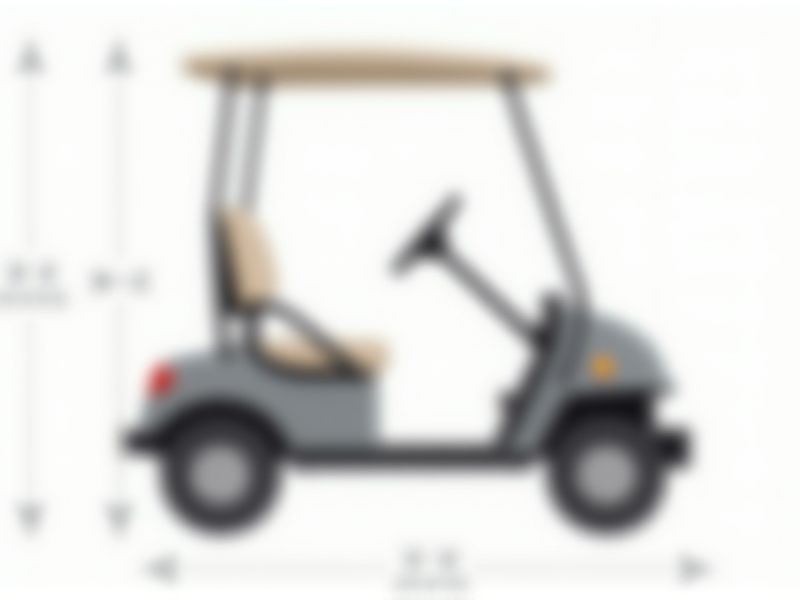
When considering the standard dimensions of a golf cart, it's useful to know that most two-seater models are approximately 4 feet wide, 8 feet long, and around 6 feet tall. These dimensions make it easy for golf carts to fit on standard cart paths and in typical garage spaces. If you're planning transport, storage, or customizing a golf cart, knowing these measurements helps ensure compatibility with trailers and enclosures. Always double-check the manufacturer's specifications, since sizes may vary slightly based on the make and model.
Width
The standard width of a golf cart typically ranges between 4 to 5 feet, ensuring stability and ease of maneuverability on the course. This dimension allows for comfortable seating for two to four passengers, accommodating various body types. Designed with a focus on both performance and aesthetics, many models feature a width that enhances driving experience, especially on narrow pathways. When considering a golf cart for your needs, ensure it meets these width specifications for optimal use.
Length
A standard golf cart typically measures around 8 feet in length, providing ample space for up to four passengers and their equipment. This dimension ensures stability and maneuverability on golf courses, allowing golfers to navigate easily between holes. Many manufacturers design carts with a width of approximately 4 feet, which complements the length for optimal turning capabilities. When choosing a golf cart, consider how this length impacts your specific needs, such as transportability and storage options.
Height
The standard height for golf carts typically ranges between 64 to 68 inches when measured from the ground to the top of the roof. This height ensures that the cart can comfortably accommodate passengers, including those who may be seated securely while wearing hats or other headgear. Depending on the manufacturer, some models feature adjustable heights to cater to specific needs, enhancing usability. Ensuring your golf cart meets this height standard can improve overall safety and accessibility on the course.
Wheelbase
The wheelbase of a standard golf cart typically ranges from 45 to 70 inches, directly influencing stability and maneuverability on the course. A longer wheelbase enhances ride comfort and stability at high speeds, while a shorter wheelbase allows for greater agility and tighter turns, ideal for navigating narrow pathways. Standard golf carts usually feature a wheelbase of approximately 50 to 55 inches, making them suitable for diverse terrains. When selecting a golf cart, consider how the wheelbase aligns with your personal driving preferences and the layout of your golf course.
Ground Clearance
Ground clearance in golf carts typically ranges from 4 to 6 inches, allowing for better maneuverability over uneven terrain. This measurement is crucial for preventing damage to the undercarriage when navigating golf courses or hilly landscapes. Higher ground clearance can enhance stability and traction, especially in wet or sandy conditions, while lower clearance offers a smoother ride on flat surfaces. When selecting a golf cart, consider how ground clearance will affect your overall experience and the specific terrains you plan to traverse.
Weight Capacity
The standard weight capacity of a golf cart typically ranges from 800 to 1,200 pounds, depending on the model and manufacturer. This limit generally includes the combined weight of passengers, clubs, and any additional cargo. For optimal safety and performance, it's essential to adhere to this weight limit, as exceeding it can lead to reduced maneuverability and increased wear on the cart's components. When choosing a golf cart, consider your specific needs and ensure it can comfortably accommodate your expected load.
Cargo Bed Dimensions
The standard golf cart typically features a cargo bed with dimensions ranging from 32 to 40 inches in width and around 36 to 42 inches in length, designed to accommodate various materials and equipment. Most cargo beds can support a weight capacity of approximately 800 to 1,200 pounds, depending on the model and manufacturer. This spacious design is ideal for transporting golf bags, coolers, and other essentials, enhancing your on-course experience. If you prioritize utility, consider models with reinforced beds and customizable options to maximize functionality.
Turning Radius
The standard turning radius for a golf cart typically ranges between 10 to 15 feet, allowing for efficient navigation on golf courses. Smaller turning radii enhance maneuverability, making it easier to navigate tight spaces and sharp corners. For optimal performance, many golf carts feature a tight steering ratio, which further reduces the effort needed to make sharp turns. When selecting a golf cart, consider how the turning radius will impact your ability to traverse the course effectively.
Tire Size
The standard tire size for golf carts typically ranges from 18 to 20 inches in diameter, depending on the model and intended use. Larger tires, such as 23 inches, offer improved traction and a smoother ride on uneven terrain, while smaller tires provide better maneuverability on flat surfaces. Maintaining proper tire pressure, usually between 12 to 15 PSI, is crucial for enhancing performance and extending tire life. When selecting tires, consider the weight of the golf cart and its payload capacity to ensure optimal handling and safety during use.
Seating Configuration
When selecting a golf cart, the seating configuration is crucial for comfort and practicality. Standard golf carts typically accommodate two to four passengers, with options for rear-facing seats that provide additional seating capacity. High-end models may offer advanced ergonomic designs, ensuring optimal support during your rounds. Choosing a cart with adjustable seats can enhance your overall experience, allowing you to personalize the ride to your needs.
